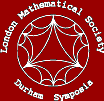 |
| Home |
| Outline |
| Participants |
Programme |
| Online Talks |
| Abstracts |
| Photos |
 |
| London
Mathematical Society Durham Symposium |
| Mathematical Aspects of Graphical Models |
| Monday 30th June - Thursday 10th July 2008 |
| Outline A number of specific topics of interest are described below, all representing research areas which are currently active and where progress is expected to be made in the immediate future. For the sake of overview it has been attempted to group these under a number of subheadings, although they are more interrelated than this grouping may suggest.
Structure and semantics of graphical modelsProperties and models of conditional independence structuresImportant recent developments have been concerned with the study of specific types of conditional independence structures and understanding their properties. Recent developments are successfully exploiting ideas from computational algebraic geometry and combinatorics. Causal interpretation Since the pioneering work of Pearl graphical models have proved fundamental for expressing, understanding and manipulating causal relationships in complex systems. The calculus and full understanding still needs further study and many fundamental issues with bearing to epidemiology of various forms still need to be resolved. Statistical theory and methodologyAnalysis of complex systemsGraphical models are fundamentally modular, allowing the specification, manipulation, and analysis of large, complex models exploiting efficient algorithms and local specification of simple modules. A few attempts have been made to describe and understand a calculus that enables simple combination and decomposition of specific elements of the models, one of the most refined for the being probabilistic relational models, combining ideas from relational database theory with graphical models. To enable full flexibility of such analysis and conceptually support development of efficient software, further developments and abstractions are required. Structure estimation and identification A particular interesting challenge is to understand and develop models and theory for estimating the structure of a graphical model, in its simplest version being equivalent to identifying the graph describing the relationships between variables in the model. This area is currently developing rapidly, but needs a solid theoretical and mathematical underpinning. Specific multivariate distributions Dawid and Lauritzen introduced the notion of hyper Markov laws. These were probability measures on the parameter space for graphical models which in various ways reflect the structure of the model itself. Recently, Letac and Massam and others have shown that new interesting distributions occur in this way and studied their mathematical properties. These new distributions can occur as natural conjugate prior distributions for a Bayesian analysis of graphical models, in particular extending the type of posterior distributions over graphs that can be used and understood. Stochastic networks Stochastic networks are playing an ever more fundamental role in the study of social networks and a number of other contexts. The mathematical study of models for random graphs is moving rapidly ahead and its precise role within graphical models research needs to be understood. A Bayesian approach to inference about structure, as mentioned above, leads naturally to random graph models both for prior and posterior information. Computational theory and methodologyVariational inferenceWhen explicit inference is impossible it has been demonstrated that so-called variational methods can be both efficient and yield results of an acccuracy which can be sufficient for certain purposes. Wainwright and Jordan have made substantial progress in understanding the mathematical aspects of these, but many unanswered questions remain. Markov Chain Monte Carlo methods Research in this area is generally abundant. For the specific case of this symposium it is of interest to study algorithms which exploit the graphical structure in a sophisticated way and relies as much as possible on exact computation. An important development is obtained by so-called blocking Gibbs sampling, but no specific way of proving correctness of the associated algorithms is currently known. Approximate propagation algorithms For graphical models used in communication theory methods involving so-called loopy propagation have empirically been shown to be dramatically superior to anything known earlier, essentially enabling decoding at a rate very close to the Shannon floor. Although substantial progress has been made in understanding why and when these methods are so effective, the fundamental issues are still largely unresolved. |
| Organising Committee: Philip Dawid (University of Cambridge) Stefen Lauritzen (University of Oxford) |